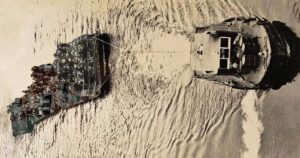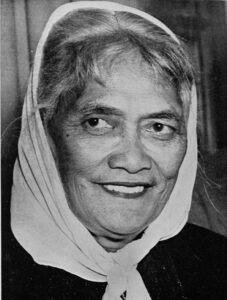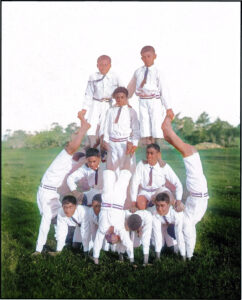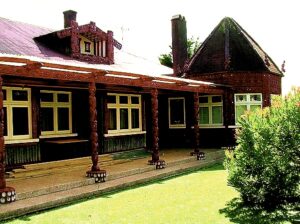1921: Turangawaewae
August 11, 2024
By AHNZ
 On the morning of 11 August 1921, Maori Royalty and a group of Waikato Tainui pushed forward on a great project to restore their old capital at Ngaruawahia. They were led by Te Puea Herangi who had made herself prominent resisting the Great War a few years earlier. Ref. 1918: Te Paina Marae Raid, AHNZ
On the morning of 11 August 1921, Maori Royalty and a group of Waikato Tainui pushed forward on a great project to restore their old capital at Ngaruawahia. They were led by Te Puea Herangi who had made herself prominent resisting the Great War a few years earlier. Ref. 1918: Te Paina Marae Raid, AHNZ
“On the morning of 11 August 1921, the dynamic tribal leader Princess Te Puea Herangi, of Ngati Mahuta, and 170 followers from the Maori village at Mangatawhiri, on the north Waikato, loaded and then boarded river barges, of the Roose Shipping Company, and were towed over two days to a raw, overgrown piece of land upriver at Ngaruawahia, where they hoped to establish a new, rejuvenated marae and living space.” – Tony Brunt, Facebook (2021)
The townsfolk of Ngaruwahia were bemused and suspicious as Te Puea’s people took up residence on an old bit of gorse scrub, blackberry, and gum tree swampland. There were already buildings there, even a rubbish dump, but the river trek started that day with some 200 colonists became a successful reclaiming of the old territory.
The old kings had used Ngaruawahia as their base to invade New Zealand in the 1860s and in defeat had it taken away from them. Earlier still, it had been the base from which to murder and enslave other tribes. So, restoring the capital and creating Turangawaewae Marae did not please all.
This is New Zealand history, the making of our country and the story of our race relations. It is also the subject of major land deals and concessions and hand-overs and, most recently (2020,) a $370,730 Provincial Growth Fund donation from Labour 6.0. Access to our history is the preserve of all New Zealanders or even, says I, their civic responsibility.
“For us in the North, Turangawaewae Marae is a symbol of that slavery, murder and cannibalism, and so needs to be pulled down…“The wealth that Tainui generated was made on the backs of Ngāpuhi slaves.” Ref. Rankin calls for Turangawaewae Marae to come down, Kiwiblog (2020)
“In October 2020, the Government committed $370,730 from the Provincial Growth Fund to upgrade the marae, creating 30 jobs.” – Wiki
“It may have been a day of hope in Te Puea’s mind but everybody was crying. It was like the feeling our ancestors must have had when they left Hawaiki – families were being divided, friends were being left behind. We were going on a journey from the known to the unknown. We were leaving a place that had so much history for us, the home where most of us had grown up, played, made friends, fallen in love, and been taught everything we knew …I cried freely with the old people.” – Piri Poutapu (15yr old) taken in Te Puea’s retinue. Ref. Michael King quoted by Brunt (2021)

You might well ask why taxpayers are supporting the upkeep of a privately owned property? That is the right question and only the latest tip of the Turangawaewae iceberg.
Te Puea’s was a government project despite her apparently being radically anti-state during the years of the First World War. At the age of 28 (1911) she was unmarried and was unable to bare children so discovered a new identity for herself based on royal blood. ‘Royal’ in the sense that Tainui tribal chiefs have successfully styled themselves as King where others go by ‘chief’ or, more commonly, no title at all.
After the impressive passive resistance of her war years, Te Puea’s next opportunity came during the 1918 Influenza Pandemic. In particular, she started claiming ‘orphan’ children and putting them to work for her start-up. This process was explained by Rawiri Waretini-Karena speaking to Michael Laws as part of his family abuse cycle…
“Though my grandfather wasn’t orphaned he was collected up among the children…Te Puea would send them out to work on the farms and they would bring the money back…from it they bought musical instruments and cloth…performed….used that money to buy the land where Turangawaewae Marae now resides.”– Ref. Rawiri Waretini-Karena on Colonisation, State Abuse & Jail. The Platform (1 August, 2024)
Rawiri went on to say that this Maori Battalion grandfather was psychotic in adulthood leading to Rawiri and his brother and his father being criminally violent and sent to prison. No wonder he’s concerned now about the abuse in State care. It’s a Family System that started out with Te Puea’s scheme to create her own workforce of singing and dancing “orphan” children which she called Te Pou o Mangawhiri (TPM.) This name was a political statement intended to “remind the Pākehā of the war and the confiscations.” Ref. Wiki
Another of these “orphans” was Piri Poutapu who seemed not to lack parents either. Ref. Te Ara
Yet another of Te Puea’s workers was Tumokai Katipa who ended up marrying the Princess in 1922, when he was 21 and she was 38. As Michael King pointed out too, Puea aged quite rapidly “worn out…seemed much older.” Ref. p58 King (1988)
“..she would always find justification in tradition, most often in the whakatauki or proverbs of Tawhiao. Even when breaking with tradition..” – King (1993)
 That whole TPM generation grew up working on the farm. A sort of perverted version of the Te Kao Boys of 1913 who may have inspired the Princess (image, right.) But these boys were educated and the rewards they earned were for them. The King Movement seems to have “whangaied” (taken on someone else’s children) these youth for the collective. Judging by Waretini-Karena’s statement many of them may have been kept ignorant of the English language. All the better to keep them from disclosing what life was like at Turangawaewae.
That whole TPM generation grew up working on the farm. A sort of perverted version of the Te Kao Boys of 1913 who may have inspired the Princess (image, right.) But these boys were educated and the rewards they earned were for them. The King Movement seems to have “whangaied” (taken on someone else’s children) these youth for the collective. Judging by Waretini-Karena’s statement many of them may have been kept ignorant of the English language. All the better to keep them from disclosing what life was like at Turangawaewae.
Rather than be vilified the way Centrepoint commune or Gloriavale ‘cult’ are, Te Puea’s intentional community enjoys protective status in our state history books. They record that Puea wed Katipa “at the wish of the kāhui ariki” (Royal Family) which makes it seem as if any impropriety belongs to someone other than Puea. It might also be that the marriage was intended to sanctify a coupling relationship between the princess and one of¹ her boys.
Big Time Princess

Te Puea’s charity and touring show boys had raised funds on the pretense of building a hospital for the Maori community. This was recognised and accepted in time times of their poverty and in the wake of the 1918 outbreak. However, when the time came to spend the money the Princess instead invested in freeholding a farm and creating the great Turangawaewae Marae. And, in 1938, a Magnificent Residence for her royal family.
The Princess was able to come to such prominence because Maori King 4.0 (Te Rata Mahuta) was party crippled and almost always in poor health. To the King’s anger, the Princess muscled in on his royal territory. “Conflict with “King” Mahuta and influential elders led to their disapproval and subsequent open criticism of Te Puea.” Ref. Encyclopedia of New Zealand, McLintock (1966)
After Te Rata’s death on 1 October 1933 the project of the new Royal Residence, Turongo House, was in motion. It was the death of Rata that led to the death of Harry Holland which paved the way for the Labour Party to blast off. Ref. 1933: Death of Harry Holland, AHNZ
A more complicit Maori King 5.0 reluctantly took on the role despite lamenting that his supposed subjects lived in such poverty as to be unable to afford a king at all. But, Te Puea knew how to pull the right strings. While her workers generated labour for nothing she was able to travel the world and her husband enjoy toys like his Harley Davidson motorcycle. “Te Puea insisted on sacrifices by Waikato craftsmen who responded by working for three years without payment. Similar sacrifices were asked of, and given by, the men..” Ref. McLintock (1966)
 Te Puea even taxed her own subjects in actual money as well as their time and effort! “Te Puea restarted the Kīngitanga taxation scheme whereby all Kīngitanga supporters were required to pay levies to support Kīngatanga programmes. This was commonly called the whitebait levy.” Ref. p 202, King (1977).
Te Puea even taxed her own subjects in actual money as well as their time and effort! “Te Puea restarted the Kīngitanga taxation scheme whereby all Kīngitanga supporters were required to pay levies to support Kīngatanga programmes. This was commonly called the whitebait levy.” Ref. p 202, King (1977).
A great source of revenue for the Royal Princess came from her best friend in government, Apirana Ngata. He served as Minister for Native Affairs between 10 December, 1928, and 1 November 1934. He was her patron, she was his client. It was the same arrangement for the ‘Brown Mandate’ that Ratana would strike with Labour later. It made Te Puea a legend in the state history books and paid for her lifestyle and accommodations. Ref. A Church of Politics, AHNZ
Indeed, because the Tainui ‘Royals’ owed their income stream to Ngata they named the Mahinarangi Meeting House and Turongo House after his people rather than theirs.
Turongo (1938) only outwardly appears Maori-like. Really it was deliberately a copy of a home that Te Puea had observed in Hamilton. In accord to her wishes, the Fifth Maori King approached the owners for formal permission to replicate it. “Interestingly, the Maori King modelled this residence on my Grandfather’s (Oliver Schofield) Hamilton house which had been constructed some years earlier. Oliver had designed and hand-built this house which had a blend of Lancashire and Californian architecture, and featured the conical “Queen Anne Tower”. The King knocked on the door and formally asked permission to replicate this house, which still stands today.” Ref. Geoff Collins, New Zealand: History & Natural History, Facebook (2020)
“Turangawaewae began to take on the character of a national marae, and she had access to the resources of the state with which to achieve her objectives and heighten her mana (though some conservatives in Waikato referred to her disparagingly as ‘Mrs Kawanatanga’ on account of her association with politicians)..”
“It was while Te Puea was approaching the height of her influence that the most florescent era in national Maori affairs to that time came to an end. In October 1934 Apirana Ngata resigned his cabinet portfolio…not adequately accounting for the expenditure of state funds, and possibly favouring the interests of his own tribe. None of these matters was criminal…a sad end to a ministerial career which had seen him at one point, in 1930, holding the position of acting Prime Minister.” – King (1993)
“She was able to acquire from the government a block of land near the meeting house for growing vegetables, increased pensions and a local post box. The Prime Minister Gordon Coates also gave her a 200-acre farm, built her a house and made a gift of £1,000 for farm development; and also subsidised a Māori workers’ hostel in Tuakau. Coates said this was given in recognition of her work for Waikato orphans and the poor but also to consolidate her political support at a time when the Rātana church was becoming a major and threatening political force. Ngata gave Te Puea government loans and another 300-acre block to grow food to support the Kīngitanga. This farm needed a developer and an experienced Pākehā farmer paid for by the government was appointed supervisor. Ngata fired him and replaced him with Te Puea. She was given a car so she could move around the three farms. Her husband was given another farm at Tikitere in Rotorua.” – Wiki
“This is ancestral knowledge”“Surely the mana this story has [is] enough?”“as far as Maori goes …..it’s definitely not for you. That’s ours”“Shocked, disgusted, angered…tūpuna that they have absolutely no affiliation, no connection to.” – Unexpected Facebook comments AHNZ met when starting to learn about Turangawaewae’s history
So, unfortunately for Princess Te Puea she lost her great patron when Minister Ngata was forced to resign (October 1934) in ignominy due to the spending scandal. The Kingship (“Kingitanga “) still going today and the heritage property are relics of that time period (1928-34 especially) when Te Puea’s reputation was roaring. No wonder it needs taxpayer top-ups to sustain it as it was never the independent unit Te Puea pretended it to be. Nor was it the hospital she pretended the money was for. The bait-and-switch turned that into a royal estate and friends in government took the blame by saying that the hospital was refused a licence!
There is an agenda in controlling the Turangawaewae Marae story. If the wrong information becomes public then millions of dollars and a royal throne is at potential risk.
—
1 Hopefully just the one
Image ref. Roose Shipping Co. launch and barges on the Waikato River, Mercer Art & History Museum (edited, composite, re-creation). Tony Brunt, Facebook (2021)
Ref. Te Puea: a Biography, Michael King (1977)
Ref. After The War, Michael King (1988)
Ref. The Penguin History of New Zealand, Michael King (1993)
Ref. 2006: The Seventh Maori King, AHNZ
 Like Comment Share
Like Comment Share





